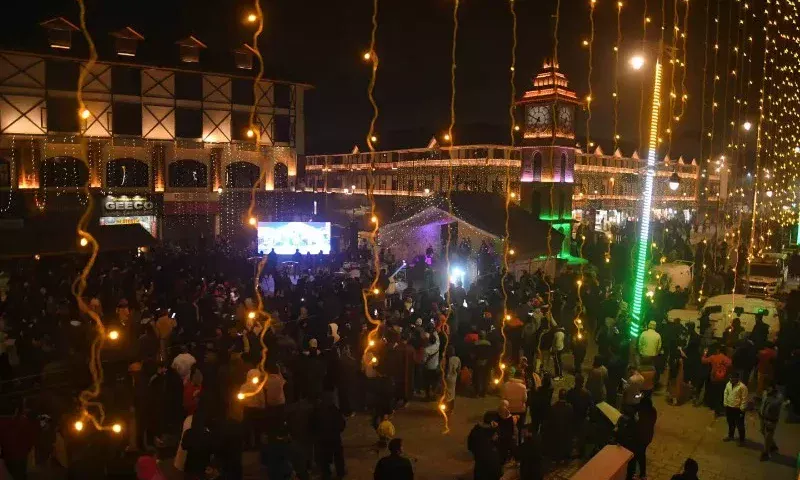Sometimes when you think you know a place, you come across a fresh aspect of it, which reminds you how little you know.
I’ve been visiting Kashmir fairly regularly for more than twenty years. I have been to Hari Parbat fort, the magnificent Mughal-era monument which dominates the Srinagar skyline. But I had never before come across the small, quiet, community that nestles in its shadow.
Two thousand or more Tibetans have made their home in Srinagar. These are Tibetan Muslims. A few Muslim families remain in the Tibetan capital, Lhasa; some live in border hill towns; but most of them have now settled in Indian Kashmir.
Because they are, or were, Kashmiris.
Yet, their story says so much about the old trading links which once gave Kashmir its wealth – about the way those links have been thrown out of joint by the rise of rival nation states – and about the complex issues of identity which ricochet across the Himalayas.
By chance, I heard mention of what locals call the “Tibet-ian colony”, close to the almond gardens and just within Srinagar’s old city walls. I knew I was on the right track when I found a food stall selling Tibetan-style dumplings. In a back street I came across groups of women gossiping – old men ambling along to the mosque – all distinctively Tibetan in appearance.

Around the corner stood the centrepiece of the community – the modern, imposing, Tibetan Public School.
Nasir Qazi, a successful young businessman, showed me around. He’s the head of the Tibetan Muslim Youth Federation, which oversees what is clearly a well-run school that reaches well beyond the community it was established to serve. “I feel proud,” Mr Qazi told me, “that this school is something we have offered to our Kashmiri brothers and sisters.”
In the corridors, photos of the Dalai Lama’s visit are on prominent display. Tibetan Muslims don’t regard the Dalai Lama as their religious leader. “But we do honour and respect him,” Mr Qazi said, “and he loves us a lot.”
The community traces its origin to merchants who travelled along the old silk routes. They were Muslim traders from Kashmir and the adjoining area of Ladakh. Four hundred or so years ago, the then Dalai Lama granted them land in the Tibetan capital.
Over time, they married Tibetan women, mastered the Tibetan language and took up Tibetan cuisine. They became a distinct community in Lhasa, with their own mosque: prosperous, well-regarded and noted practitioners of Tibetan music.
‘Khache’
But they were never seen in Tibet as Tibetans. They were called “Khache” – meaning Kashmiris. It is a term that came to be a catch-all for Tibet’s Muslims, wherever they hailed from.
After a failed uprising against Chinese Communist rule, the Dalai Lama and thousands of his Buddhist devotees fled across the Himalayas in 1959. Then, Tibet’s Muslim community also felt restive.
They were seen by some Tibetans as collaborators with the new Chinese rulers. After a lot of diplomatic push-and-pull, in which the Indian government took an interest, Muslims were allowed to leave Tibet. Most exercised that option.
Once on Indian soil, these Muslims were regarded not as stateless refugees, but as returning Indians. For once being a “Khache” gave the community status. They were from Kashmir, they told the Indian authorities, and they were adamant about going back to their homeland.
Today, most of them work in Srinagar, but not as traders – the old routes are now sealed by impermeable modern borders. Instead, they work in much less remunerative jobs, embroidering burqas and adding the finishing touches to T-shirts sold to tourists.
Mr Qazi told me that a few decades back, when tensions between India and China eased briefly, his mother had at last been able to make a return visit to Lhasa. Mr Qazi has cousins there, but he’s never been able to meet them, or even set foot in the place that gives him his identity.

“We belong to this soil, Kashmir’s soil,” Mr Qazi insisted. Yet the community’s status is ambiguous. In Indian-administered Kashmir, only those who can demonstrate that their forebears are from the state can own land and have full rights. That’s tricky for the Tibetans – their Kashmiri lineage is too distant for this purpose.
In a region where not belonging, or being seen as outsiders, can be perilous, the community keeps a low profile. They seem content in Kashmir. But they are bound to reflect on a painful paradox.
In Tibet, they are Kashmiris. In Kashmir, they are Tibetans. There’s nowhere where they are simply themselves.




